Washington at Princeton
Washington at Princeton is a 1779 painting by Charles Willson Peale, showing George Washington after the Battle of Princeton. The original was commissioned by the Supreme Executive Council of Pennsylvania for its council chamber in Independence Hall in Philadelphia. Peale made eight copies of the painting. The original, now owned by the Pennsylvania Academy of the Fine Arts, was completed in early 1779, when Washington sat for Peale in Philadelphia.
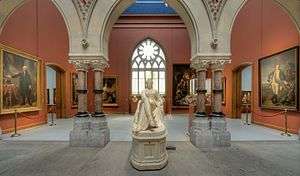
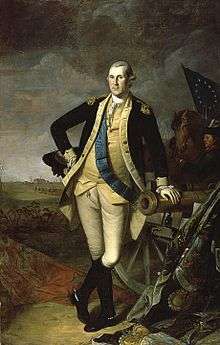
In January 2005, the painting sold for $21.3 million - setting a record for the highest price paid for an American portrait. Six of the paintings are in United States institutions including the United States Senate; the Metropolitan Museum of Art; Yale University Art Gallery; National Portrait Gallery; Colonial Williamsburg; Pennsylvania Academy of the Fine Arts; and the Faculty Room in Nassau Hall at Princeton University (where it is titled George Washington after the Battle of Princeton).
Copies of 1779 painting
The success of George Washington at Princeton led to orders for as many replicas of the painting. In August 1779 Peale wrote: “I have on hand a number of portraits of Gen. Washington. One the ambassador had for the Court of France, another is done for the Spanish Court, one other has been sent to the island of Cuba, and sundry others, which I have on hand are for private gentlemen.” [1] Copies of the painting vary in size and background, but they all feature Washington in the same posture leaning on the cannon, with a horse and a soldier in the back. Some are full-length, as the original, and some are three-quarter length. Other versions reside at Princeton University Art Museum, the Metropolitan Museum of Art in New York, Colonial Williamsburg, Virginia Museum of Fine Arts[1] and Cleveland Museum of Art.
-Peale.jpg) Copy at Princeton University Art Museum[2]
Copy at Princeton University Art Museum[2]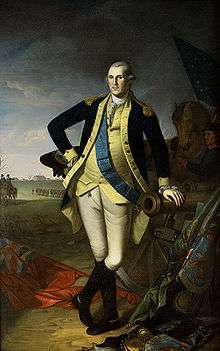 Copy at United States Senate[1]
Copy at United States Senate[1]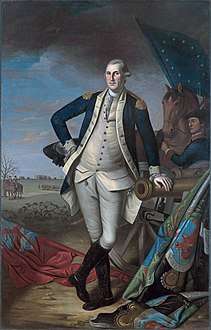 Copy at Yale University Art Gallery[3]
Copy at Yale University Art Gallery[3]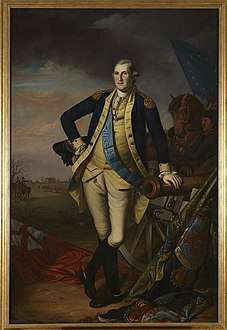 Copy at Palace of Versailles [4]
Copy at Palace of Versailles [4].jpg) Three-quarter length copy at Cleveland Museum of Art[5]
Three-quarter length copy at Cleveland Museum of Art[5]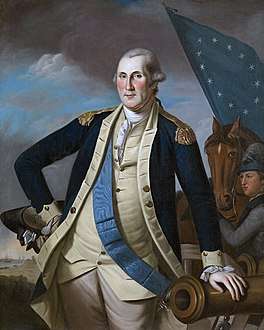 Three-quarter length copy at Crystal Bridges Museum of American Art[6]
Three-quarter length copy at Crystal Bridges Museum of American Art[6]
1783 painting
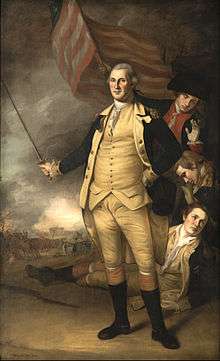
The Princeton University Art Museum displays another original Peale painting entitled George Washington at the Battle of Princeton which was commissioned in 1783 by the Trustees of the College of New Jersey (now Princeton University), the year that the Faculty Room served as a temporary Capitol of the United States. That painting, which used to hang in the Faculty Room of Nassau Hall, is displayed in a frame (with crown removed) which previously contained a portrait of King George II, which had been hung in the very same room during the Battle of Princeton, and was damaged (decapitated) by a cannonball. The location of the two Peale portraits of Washington owned by Princeton University was swapped in 2015.[7]
References
- "U.S. Senate: George Washington at Princeton". www.senate.gov. Retrieved 2 August 2019.
- "The Athenaeum - Washington After the Battle of Princeton, New Jersey (Charles Willson Peale - )". www.the-athenaeum.org. Retrieved 2 August 2019.
- "George Washington at the Battle of Princeton| Yale University Art Gallery". artgallery.yale.edu. Retrieved 2 August 2019.
- "Réunion des Musées Nationaux-Grand Palais -". www.photo.rmn.fr. Retrieved 2 August 2019.
- "George Washington at the Battle of Princeton". Cleveland Museum of Art. 31 October 2018. Retrieved 2 August 2019.
- "George Washington – Works – Crystal Bridges Museum of American Art". Retrieved 2 August 2019.
- Princeton University Art Museum